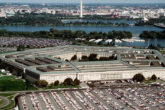July 26, 2021
The US Army’s new iron triangle: The coming budget crunch and its implications for modernization
It has come to be seen as virtually axiomatic in defense circles that the U.S. Army will serve as a bill payer for air and naval modernization, with even the chairman of the Joint Chiefs of Staff predicting a “bloodletting.” At the same time, the Army believes it must prepare for three challenges, each with distinct implications for the future force: blunting Russian aggression along NATO’s eastern frontier, defeating China in a war in the western Pacific and hedging against everything else. As a result, budget cuts will likely present the Army with something of an iron triangle among these challenges — at best only able to afford a future force prepared for two, but not all three.
As Futures Command and the Army grapple with the implications of the looming budget crunch, it is imperative that they first answer two more fundamental questions: How should the Army prioritize these challenges, and where — and how much — can it afford to take risk?
The answers to these questions will do much to provide direction for the difficult trades the Army will face in a world of shrinking budgets.
How should the Army prioritize these challenges, and where — and how much — can it afford to take risk?
Each side of the iron triangle comes with its own implications for doctrine, force structure, readiness, posture and modernization. And while there is certainly some commonality and fungibility across them, the optimal force for each differs considerably. Blunting Russian aggression entails conducting large-scale maneuver warfare on highly contested continental battlefields. This means a future force centered on heavy armor — backed by artillery, mobile air defenses and other enablers — that is sufficiently forward-postured to be able to overcome the tyranny of time and counter a short-warning attack.
Defeating China, in the Army’s view at least, entails contributing kinetic and non-kinetic fires, air defense, and other enablers to support the joint force in a primarily air and maritime fight. This means a fires- and enabler-centric future force that can operate in a highly geographically dispersed fashion across the vast expanses of the Pacific theater. Although the strategic deployment problem is somewhat less acute as compared to Europe, the distances involved coupled with Chinese counter-intervention capabilities still calls for a force posture oriented on forward presence and rapid reinforcement.
Read the full article from Defense News.
More from CNAS
-
Lessons in Learning
Executive Summary Although claims of a revolution in military affairs may be overhyped, the potential for artificial intelligence (AI) and autonomy to change warfare is growin...
By Josh Wallin
-
The Pentagon Push to Change an “Antiquated” System
Carlton Haelig, a fellow at the Center for a New American Security, joined The Cipher Brief to discuss the systems in place in the Department of Defense and the challenges ass...
By Carlton Haelig
-
The Department of Defense’s Breakthrough Nuclear Moment Risks Slipping Away
Unless they act, the Department of Defense’s breakthrough nuclear moment may vanish before it really happens....
By Will Rogers
-
DEFAERO Strategy Series [Apr 09, 25] CNAS' Becca Wasser and Phil Sheers on Revitalizing the U.S. Defense Industrial Base
On this episode of the Defense & Aerospace Report Strategy Series, sponsored by General Atomics Aeronautical Systems, Becca Wasser and Phil Sheers of the Center for a New Amer...
By Becca Wasser & Philip Sheers




